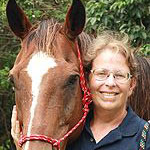TAILS FROM THE TRAILS
Selling a horse is emotionally difficult for human and equine alike. For me personally, coming to that point where I have to sell a horse is never an easy decision. My horses are family members. How do you sell a family member? But horses are also incredibly expensive, and there are times when a horse is no longer suitable — one or the other of us needs to move on.
I always try to ensure a good match between my horse and his new owner, and mostly things have worked out well. A few times they haven’t. And one time, a disaster resulted that took me years to overcome.
The first time I sold a horse was purely for financial reasons. I was in graduate school, and the choice came down to affording food for either the horse or myself. He was my first horse, a wonderful horse. I stood in the barn driveway, holding a check, and watched my good friend drive away in a stranger’s trailer. That was tough.
It did get a little easier, over the years. One excellent match resulted when I sold a wonderful mare to a good friend who’d been out riding with me weekly for a year or more. She and the mare, Ginger, were a perfect match. My friend still owns Ginger, and I’ve never lost one minute of sleep worrying.
While I owned Ginger, I bred her three times and ended up selling all three foals. One foal I couldn’t wait to get rid of, one ended in sadness, and the third ended in disaster.
Ginger’s second foal was a little filly. Ginger had been pregnant with twins, found early on an ultrasound, and the vet pinched off one. Perhaps the hormones I gave Ginger before the procedure affected the remaining fetus, because as soon as this filly hit the ground, it became clear she hated people and wanted nothing to do with them. She was difficult to work with. I sold her as soon as I weaned her, and never missed her one day.
Ginger’s third and last foal was one of those perfect, golden colts. Biscuit never minded doing anything I asked of him and always had a cheerful, friendly outlook. I was actually selling another horse I owned, and someone who came to try that horse fell in love with Biscuit and somehow managed to talk me into selling him. He was only a yearling.
I visited him a few times, and all was well, when suddenly the new owner quit taking my calls. It took me a while to find out what happened. Working with a trainer, the new owner broke Biscuit and was riding him, but he dumped her hard, so she decided to sell him. The trainer sold him and kept the money, and a lawsuit ensued. The trainer had the money, the old owner had the papers, and some unknown person had Biscuit.
A few years later I found him again, for sale, and went out to visit, even though I couldn’t afford to buy him back. I rode him for the first time, my grown-up baby. The girl who eventually bought him seemed like a dream come true, someone who would love and keep him forever, but when I again visited, Biscuit had morphed from the colt with a perennial sunny disposition to a horse so angry and miserable that he stood on the cross-ties biting at air.
His new owner decided he’d be a show horse, and all he ever did was stand in a stall or on cross-ties. His coat had to be perfect, without one speck of dust or dirt. He was never allowed to just be a horse. I quit going to visit. I couldn’t stand to see my baby so miserable.
And then there was Ginger’s first colt, a wonderful big bay named Max, the horse I thought I’d always keep. The one that ended in disaster.
Max was a great colt, the first baby I raised from day one. Everything went fine. I showed him at halter when he was six weeks old, Ginger by his side. I backed him at 2, rode on trails, entered Walk Trot classes. Everything was perfect. Except every few months, he popped an abscess, and each time, it got a little worse. The vet advised me Max’s hooves couldn’t tolerate South Florida’s wacky weather: either too wet or too dry. Sadly, I decided I’d sell him to someone who could bring him up north where his feet would fare better.
One day, a woman came to try him and brought along her trainer. I couldn’t put my finger on it, but something about her gave me the willies. My stomach started rolling. I didn’t want her on my horse, but here she was, along with her trainer.
I rode Max, who was finally sound again after months of work, then the trainer rode him. Then it was time for the woman to try him, and again, my stomach was in knots. I ignored it and held the reins while she mounted.
I can still picture it all. Max walked forward, and for some unknown reason the woman snatched back hard on the reins. Confused, Max backed up, but she kept tugging back, wrenching his head around. Surprised, Max half-reared, trying to free his head. The woman fell back, still holding the reins. Max reared up and she fell back, pulling him over backward. He landed beside her, his hind right leg awkwardly bent.
The woman was shaken but unharmed. She and her trainer left, telling me Max “wasn’t what they were looking for.” What I didn’t realize at the time was that she’d broken his leg. I ended up giving him away as a companion horse. He was only 3 years old.








